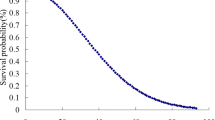Abstract
Earthquakes result in overwhelming demand for medical resources at once, and affected areas requires reinforcement from neighbor cities. An effective allocation approach of medical rescue teams in early stage of disaster relief can improve rescue performance significantly. To find optimal allocation strategy, an integer nonlinear programming model is established, following utility principle. To construct the optimization model, stochastic transition probability of triage levels is introduced. Meanwhile, function from allocation scheme to fatalities of areas is established. Next, we design algorithm based on Lingo software to find solution of utility model. Finally, numerical experiments based on real data in 2008 Sichuan earthquake in China are used to compare utility approach with existing approaches in practice. The results of experiments indicate that: (1) to save more lives, a support team should preferentially be allocated to a worse and nearer affected area. When the worst area is not the nearest, the team also may be sent to an area with moderate severity and moderate distance. (2) Compared with severity strategy and distance strategy, utility strategy improves rescue efficiency significantly.




Similar content being viewed by others
References
Ajami S, Fattahi M (2009) The role of earthquake information management systems (EIMSs) in reducing destruction: a comparative study of Japan, Turkey and Iran. Disaster Prev Manag 18:150–161
Altay N, Green WG (2006) OR/MS research in disaster operations management. Eur J Oper Res 175:475–493
Armstrong JH, Frykberg ER, Burris D (2008) Toward a national standard in primary mass casualty triage. Disaster Med Public Health Prep 2(s1):8–10
Cao H, Huang S (2012) Principles of scarce medical resource allocation in natural disaster relief: a simulation approach. Med Decis Making 32:470–475
Carlos C (2011) Effective patient prioritization in mass casualty incidents using hyper heuristics and the pilot method. OR Spectrum 33:699–720
Chu X, Zhong QY, Khokhar SG (2015) Triage scheduling optimization for mass casualty and disaster response. Asia Pacif J Oper Res. doi:10.1142/S0217595915500414
Felix W, Guido S, Stefan F et al (2014) Emergency response in natural disaster management: allocation and scheduling of rescue units. Eur J Oper Res 235:697–708
Feng L, Wang LM, Chen L et al (2009) Method of triage and remedy for earthquake casualties. Mod Med Health 25:323–325 (in Chinese)
Fiedrich F, Gehbauer F, Rickers U (2000) Optimized resource allocation for emergency response after earthquake disasters. Saf Sci 35:41–57
Frykberg ER (2004) Principles of mass casualty management following terrorist disasters. Ann Surg 239:319–321
Hina A, Raghu TS, Vinze A (2010) Resource allocation for demand surge mitigation during disaster response. Decis Support Syst 50:304–315
Horner MW, Downs JA (2010) Optimizing hurricane disaster relief goods distribution: model development and application with respect to planning strategies. Disasters 34:821–844
Hu WJ, Zhao WH, Li YF et al (2010) Analysis of emergency medical staging in Wenchuan earthquake casualty treatment. Pract J Clin Med 7:20–24 (in Chinese)
Huseyin OM, Zelda BZ (2010) Stochastic optimization of medical supply location and distribution in disaster management. Int J Prod Econ 126:76–84
Iserson KV, Moskop JC (2007) Triage in medicine, part I: concept, history, and types. Ann Emerg Med 49:275–281
Jian HS, Ma JF (2010) Significance of casualty time curve in medical rescue of Wenchuan earthquake. J Traum Surg 12:535–537 (in Chinese)
Jiang YW, Zhang JC, Zhong Y et al (2008) Summary of triage after Wenchuan earthquake in 2 weeks. Chin J Evid Based Med 8:722–725 (in Chinese)
John CM, Kenneth VI (2007) Triage in medicine, part II: underlying values and principles. Ann Emerg Med 49(3):282–287
Lei BL, Zhou Y, Zhu Y et al (2008) The emergency response of medical rescue in the worst-hit Mianyang areas after Wenchuan earthquake. Chin J Evid Based Med 8:581–587 (in Chinese)
Narjès BS, Tarek BM, Julie D et al (2006) Assessing large scale emergency rescue plans: an agent based approach. Int J Intell Control Syst 11:260–271
Pamela CN, Karl FD, Richard FH (2010) Water distribution in disaster relief. Int J Phys Distrib Logist Manag 40:693–708
Wilson DT, Hawe GI, Coates G et al (2013) A multi-objective combinatorial model of casualty processing in major incident response. Eur J Oper Res 230:643–655
Zhang JH, Li J, Liu ZP (2012) Multiple-resource and multiple-depot emergency response problem considering secondary disasters. Expert Syst Appl 39:11066–11071
Acknowledgments
This research was sponsored by National Science Foundation of China (No. 91024029).
Author information
Authors and Affiliations
Corresponding author
Rights and permissions
About this article
Cite this article
Chu, X., Zhong, Q. Post-earthquake allocation approach of medical rescue teams. Nat Hazards 79, 1809–1824 (2015). https://doi.org/10.1007/s11069-015-1928-y
Received:
Accepted:
Published:
Issue Date:
DOI: https://doi.org/10.1007/s11069-015-1928-y




